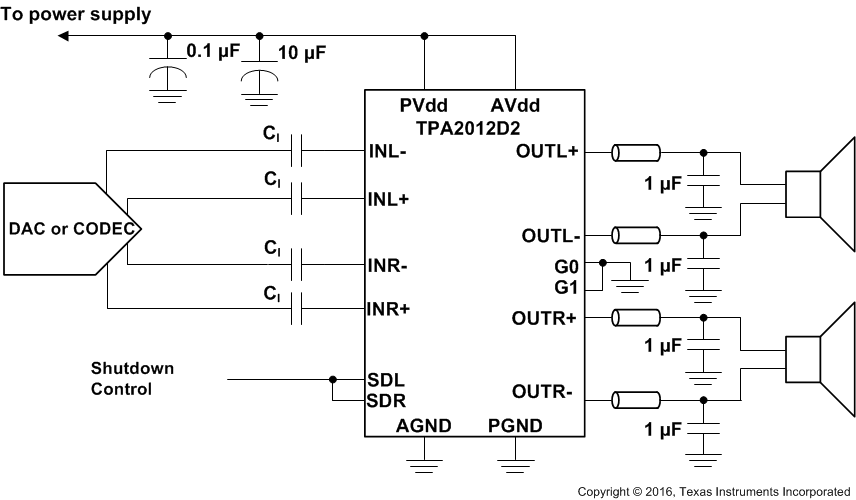-
TPA2012D2 2.1-W/Channel Stereo Filter-Free Class-D Audio Power Amplifier
- 1 Features
- 2 Applications
- 3 Description
- 4 Revision History
- 5 Device Comparison Table
- 6 Pin Configuration and Functions
- 7 Specifications
- 8 Parameter Measurement Information
- 9 Detailed Description
- 10Application and Implementation
- 11Power Supply Recommendations
- 12Layout
- 13Device and Documentation Support
- 14Mechanical, Packaging, and Orderable Information
- IMPORTANT NOTICE
TPA2012D2 2.1-W/Channel Stereo Filter-Free Class-D Audio Power Amplifier
1 Features
- Output Power By Package:
- WQFN:
- 2.1 W/Ch Into 4 Ω at 5 V
- 1.4 W/Ch Into 8 Ω at 5 V
- 720 mW/Ch Into 8 Ω at 3.6 V
- DSBGA:
- 1.2 W/Ch Into 4 Ω at 5 V
(Thermally Limited) - 1.3 W/Ch Into 8 Ω at 5 V
- 720 mW/Ch Into 8 Ω at 3.6 V
- 1.2 W/Ch Into 4 Ω at 5 V
- WQFN:
- Only Two External Components Required
- Power Supply Range: 2.5 V to 5.5 V
- Independent Shutdown Control for Each Channel
- Selectable Gain of 6, 12, 18, and 24 dB
- Internal Pulldown Resistor on Shutdown Pins
- High PSRR: 77 dB at 217 Hz
- Fast Start-Up Time (3.5 ms)
- Low Supply Current
- Low Shutdown Current
- Short-Circuit and Thermal Protection
- Space-Saving Packages
- 2.01-mm × 2.01-mm NanoFree™ DSBGA (YZH)
- 4-mm × 4-mm Thin WQFN (RTJ) With PowerPAD™
2 Applications
- Wireless or Cellular Handsets and PDAs
- Portable DVD Players
- Notebook PCs
- Portable Radios
- Portable Gaming
- Educational Toys
- USB Speakers
3 Description
The TPA2012D2 is a stereo, filter-free, Class-D audio amplifier (Class-D amp) available in a DSBGA or WQFN package. The TPA2012D2 only requires two external components for operation.
The TPA2012D2 features independent shutdown controls for each channel. The gain can be selected to 6, 12, 18, or 24 dB using the G0 and G1 gain select pins. High PSRR and differential architecture provide increased immunity to noise and RF rectification. In addition to these features, a fast start-up time and small package size make the TPA2012D2 class-D amp an ideal choice for both cellular handsets and PDAs.
The TPA2012D2 is capable of driving 1.4 W/Ch at
5 V or 720 mW/Ch at 3.6 V into 8 Ω. The TPA2012D2 is also capable of driving 4 Ω. The TPA2012D2 is thermally limited in DSBGA and may not achieve
2.1 W/Ch for 4 Ω. The maximum output power in the DSBGA is determined by the ability of the circuit board to remove heat. Figure 33 shows thermally limited region of the DSBGA in relation to the WQFN package. The TPA2012D2 provides thermal and short-circuit protection.
Device Information(1)
| PART NUMBER | PACKAGE | BODY SIZE (NOM) |
|---|---|---|
| TPA2012D2 | DSBGA (16) | 2.01 mm × 2.01 mm |
| WQFN (20) | 4.00 mm × 4.00 mm |
- For all available packages, see the orderable addendum at the end of the data sheet.
Simplified Application Schematic
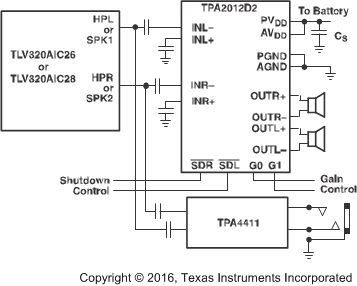
4 Revision History
Changes from E Revision (September 2016) to F Revision
- Switched the BODY SIZE values in the Device Information table: DSBGA From: 4.00 mm × 4.00 mm To: 2.01 mm × 2.01 mm and WQFN From: 2.01 mm × 2.01 mm To: 4.00 mm × 4.00 mmGo
Changes from D Revision (June 2008) to E Revision
- Added ESD Ratings table, Feature Description section, Device Functional Modes, Application and Implementation section, Power Supply Recommendations section, Layout section, Device and Documentation Support section, and Mechanical, Packaging, and Orderable Information sectionGo
- Deleted Available-Options table; see POA at the end of the data sheetGo
- Deleted previous application schematics: Typical Application Circuit (previously Figure 33), TPA2012D2 Application Schematic With Differential Input and Input Capacitors (previously Figure 34), and TPA2012D2 Application Schematic With Single-Ended Input (previously Figure 35)Go
5 Device Comparison Table
| DEVICE NO. | SPEAKER AMP TYPE | SPECIAL FEATURE | OUTPUT POWER (M) | PSRR (dB) |
|---|---|---|---|---|
| TPA2012D2 | Class D | — | 2.1 | 71 |
| TPA2016D2 | Class D | AGC/DRC | 2.8 | 80 |
| TPA2026D2 | Class D | AGC/DRC | 3.2 | 80 |
6 Pin Configuration and Functions
Pin Functions
| PIN | I/O | DESCRIPTION | ||
|---|---|---|---|---|
| NAME | DSBGA | WQFN | ||
| AGND | C3 | 18 | I | Analog ground |
| AVDD | D2 | 9 | I | Analog supply (must be same voltage as PVDD) |
| G0 | C2 | 15 | I | Gain select (LSB) |
| G1 | B2 | 1 | I | Gain select (MSB) |
| INL– | B1 | 19 | I | Left channel negative input |
| INL+ | A1 | 20 | I | Left channel positive input |
| INR– | C1 | 17 | I | Right channel negative input |
| INR+ | D1 | 16 | I | Right channel positive input |
| NC | — | 6, 10 | — | No internal connection |
| OUTL– | A4 | 5 | O | Left channel negative differential output |
| OUTL+ | A3 | 2 | O | Left channel positive differential output |
| OUTR– | D4 | 11 | O | Right channel negative differential output |
| OUTR+ | D3 | 14 | O | Right channel positive differential output |
| PGND | C4 | 4, 12 | I | Power ground |
| PVDD | A2 | 3, 13 | I | Power supply (must be same voltage as AVDD) |
| SDL | B4 | 7 | I | Left channel shutdown terminal (active low) |
| SDR | B3 | 8 | I | Right channel shutdown terminal (active low) |
| Thermal Pad | — | — | — | Connect the thermal pad of WQFN package to PCB GND |
7 Specifications
7.1 Absolute Maximum Ratings
over operating free-air temperature range (unless otherwise noted)(1)| MIN | MAX | UNIT | ||
|---|---|---|---|---|
| Supply voltage, VSS (AVDD, PVDD) | Active mode | –0.3 | 6 | V |
| Shutdown mode | –0.3 | 7 | ||
| Input voltage, VI | –0.3 | VDD + 0.3 | V | |
| Continuous total power dissipation | See Dissipation Rating Table | |||
| Operating junction temperature, TJ | –40 | 150 | °C | |
| Storage temperature, Tstg | –65 | 150 | °C | |
7.2 ESD Ratings
| VALUE | UNIT | |||
|---|---|---|---|---|
| V(ESD) | Electrostatic discharge | Human-body model (HBM), per ANSI/ESDA/JEDEC JS-001(1) | ±2000 | V |
| Charged-device model (CDM), per JEDEC specification JESD22-C101(2) | ±1500 | |||
7.3 Recommended Operating Conditions
over operating free-air temperature range (unless otherwise noted)| MIN | MAX | UNIT | ||
|---|---|---|---|---|
| VSS | Supply voltage, AVDD, PVDD | 2.5 | 5.5 | V |
| VIH | High-level input voltage, SDL, SDR, G0, G1 | 1.3 | V | |
| VIL | Low-level input voltage, SDL, SDR, G0, G1 | 0.35 | V | |
| TA | Operating free-air temperature | –40 | 85 | °C |
7.4 Thermal Information
| THERMAL METRIC(1) | TPA2012D2 | UNIT | ||
|---|---|---|---|---|
| YZH (DSBGA) | RTJ (WQFN) | |||
| 16 PINS | 20 PINS | |||
| RθJA | Junction-to-ambient thermal resistance | 71.4 | 34.6 | °C/W |
| RθJC(top) | Junction-to-case (top) thermal resistance | 0.4 | 34.3 | °C/W |
| RθJB | Junction-to-board thermal resistance | 14 | 11.5 | °C/W |
| ψJT | Junction-to-top characterization parameter | 1.8 | 0.4 | °C/W |
| ψJB | Junction-to-board characterization parameter | 13.3 | 11.6 | °C/W |
| RθJC(bot) | Junction-to-case (bottom) thermal resistance | — | 3.2 | °C/W |
7.5 Electrical Characteristics
TA = 25°C (unless otherwise noted)| PARAMETER | TEST CONDITIONS | MIN | TYP | MAX | UNIT | ||
|---|---|---|---|---|---|---|---|
| |VOO| | Output offset voltage (measured differentially) | Inputs ac grounded, AV = 6 dB, VDD = 2.5 to 5.5 V | 5 | 25 | mV | ||
| PSRR | Power supply rejection ratio | VDD = 2.5 to 5.5 V | –75 | –55 | dB | ||
| Vicm | Common-mode input voltage | 0.5 | VDD – 0.8 | V | |||
| CMRR | Common-mode rejection ration | Inputs shorted together, VDD = 2.5 to 5.5 V | –69 | –50 | dB | ||
| |IIH| | High-level input current | VDD = 5.5 V, VI = VDD | 50 | µA | |||
| |IIL| | Low-level input current | VDD = 5.5 V, VI = 0 V | 5 | µA | |||
| IDD | Supply current | VDD = 5.5 V, no load or output filter | 6 | 9 | mA | ||
| VDD = 3.6 V, no load or output filter | 5 | 7.5 | |||||
| VDD = 2.5 V, no load or output filter | 4 | 6 | |||||
| Shutdown mode | 1.5 | µA | |||||
| rDS(on) | Static drain-source on-state resistance | VDD = 5.5 V | 500 | mΩ | |||
| VDD = 3.6 V | 570 | ||||||
| VDD = 2.5 V | 700 | ||||||
| Output impedance in shutdown mode | V(SDR, SDL)= 0.35 V | 2 | kΩ | ||||
| f(sw) | Switching frequency | VDD = 2.5 V to 5.5 V | 250 | 300 | 350 | kHz | |
| Closed-loop voltage gain | G0, G1 = 0.35 V | 5.5 | 6 | 6.5 | dB | ||
| G0 = VDD, G1 = 0.35 V | 11.5 | 12 | 12.5 | ||||
| G0 = 0.35 V, G1 = VDD | 17.5 | 18 | 18.5 | ||||
| G0, G1 = VDD | 23.5 | 24 | 24.5 | ||||
| OPERATING CHARACTERISTICS, RL = 8 Ω | |||||||
| PO | Output power (per channel) | RL = 8 Ω | VDD = 5 V, f = 1 kHz, THD = 10% |
1.4 | W | ||
| VDD = 3.6 V, f = 1 kHz, THD = 10% |
0.72 | ||||||
| RL = 4 Ω | VDD = 5 V, f = 1 kHz, THD = 10% |
2.1 | |||||
| THD+N | Total harmonic distortion plus noise | PO = 1 W, VDD = 5 V, AV = 6 dB, f = 1 kHz | 0.14% | ||||
| PO = 0.5 W, VDD = 5 V, AV = 6 dB, f = 1 kHz | 0.11% | ||||||
| Channel crosstalk | f = 1 kHz | –85 | dB | ||||
| kSVR | Supply ripple rejection ratio | VDD = 5 V, AV = 6 dB, f = 217 Hz | –77 | dB | |||
| VDD = 3.6 V, AV = 6 dB, f = 217 Hz | –73 | ||||||
| CMRR | Common mode rejection ratio | VDD = 3.6 V, VIC = 1 Vpp, f = 217 Hz | –69 | dB | |||
| Input impedance | Av = 6 dB | 28.1 | kΩ | ||||
| Av = 12 dB | 17.3 | ||||||
| Av = 18 dB | 9.8 | ||||||
| Av = 24 dB | 5.2 | ||||||
| Start-up time from shutdown | VDD = 3.6 V | 3.5 | ms | ||||
| Vn | Output voltage noise | VDD = 3.6 V, f = 20 to 20 kHz, inputs are ac grounded, AV = 6 dB |
No weighting | 35 | µV | ||
| A weighting | 27 | ||||||
7.6 Dissipation Rating Table
| PACKAGE | TA = 25°C POWER RATING(1) |
DERATING FACTOR |
TA = 75°C POWER RATING |
TA = 85°C POWER RATING |
|---|---|---|---|---|
| RTJ | 5.2 W | 41.6 mW/°C | 3.12 W | 2.7 W |
| YZH | 1.2 W | 9.12 mW/°C | 690 mW | 600 mW |
7.7 Typical Characteristics
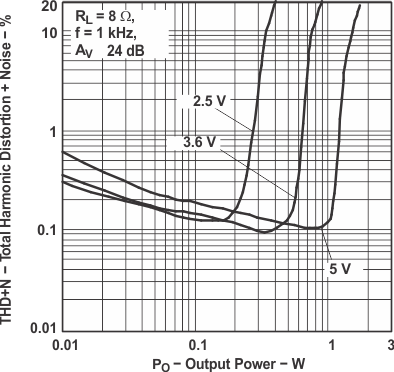 Figure 1. Total Harmonic Distortion
Figure 1. Total Harmonic Distortionvs Output Power
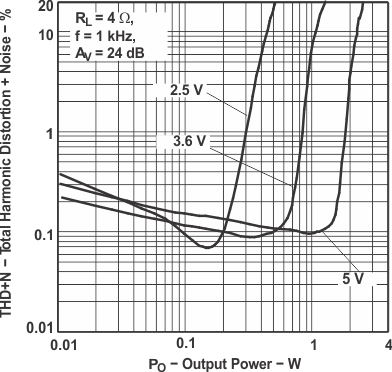 Figure 3. Total Harmonic Distortion
Figure 3. Total Harmonic Distortionvs Output Power
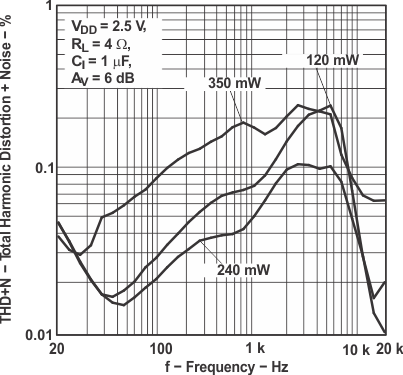 Figure 5. Total Harmonic Distortion vs Frequency
Figure 5. Total Harmonic Distortion vs Frequency
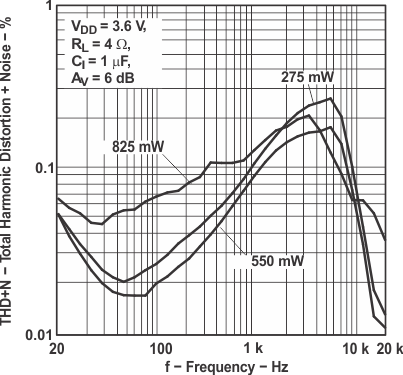 Figure 7. Total Harmonic Distortion vs Frequency
Figure 7. Total Harmonic Distortion vs Frequency
 Figure 9. Total Harmonic Distortion vs Frequency
Figure 9. Total Harmonic Distortion vs Frequency
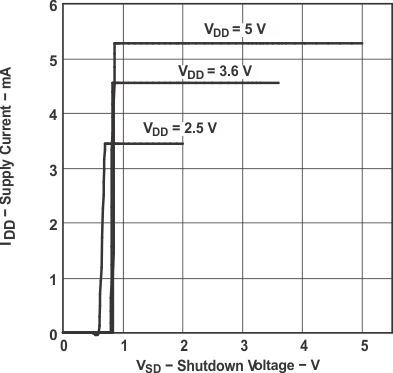 Figure 11. Supply Current vs Shutdown Voltage
Figure 11. Supply Current vs Shutdown Voltage
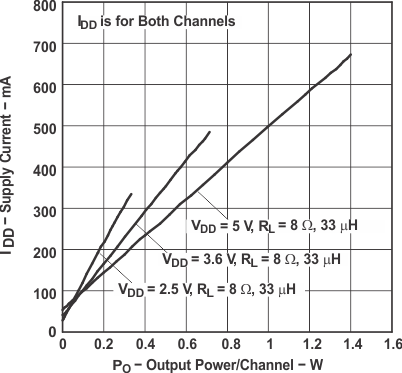 Figure 13. Supply Current vs Output Power
Figure 13. Supply Current vs Output Power
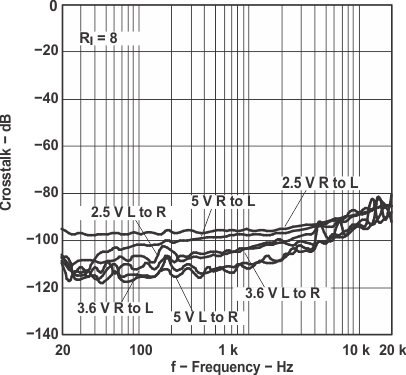 Figure 15. Crosstalk vs Frequency
Figure 15. Crosstalk vs Frequency
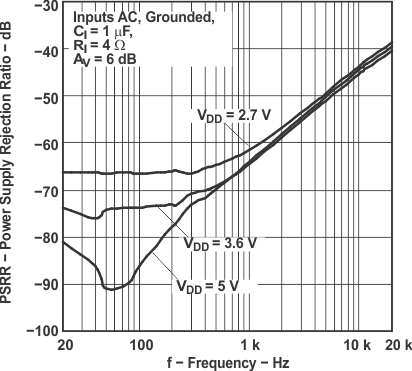 Figure 17. Power Supply Rejection Ratio
Figure 17. Power Supply Rejection Ratiovs Frequency
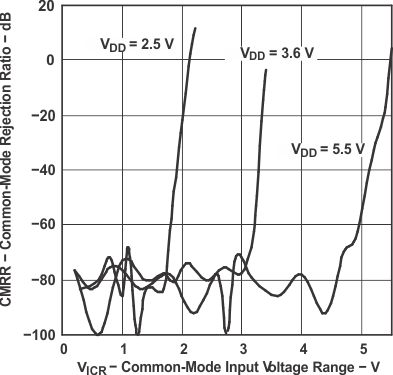 Figure 19. Common-Mode Rejection Ratio
Figure 19. Common-Mode Rejection Ratiovs Common-Mode Input Voltage
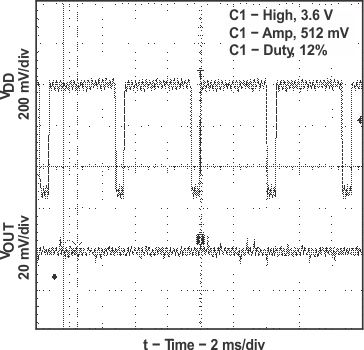 Figure 21. GSM Power Supply Rejection vs Time
Figure 21. GSM Power Supply Rejection vs Time
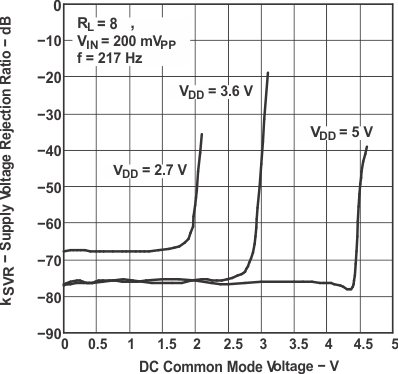 Figure 23. Supply Voltage Rejection Ratio
Figure 23. Supply Voltage Rejection Ratiovs DC Common-Mode Voltage
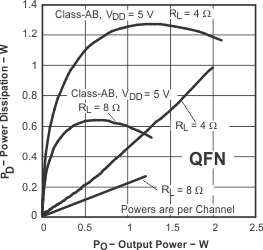 Figure 25. Power Dissipation vs Output Power
Figure 25. Power Dissipation vs Output Power
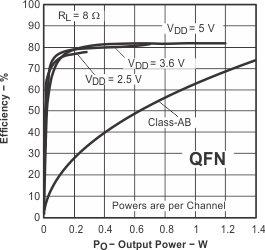 Figure 27. Efficiency vs Output Power
Figure 27. Efficiency vs Output Power
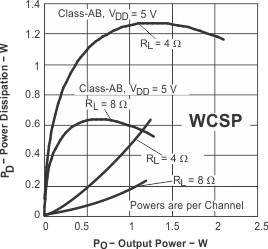 Figure 29. Power Dissipation vs Output Power
Figure 29. Power Dissipation vs Output Power
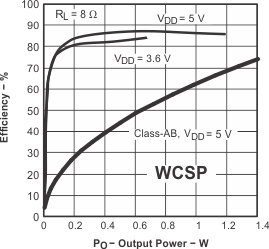 Figure 31. Efficiency vs Output Power
Figure 31. Efficiency vs Output Power
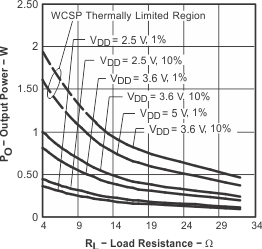 Figure 33. Output Power vs Load Resistance
Figure 33. Output Power vs Load Resistance
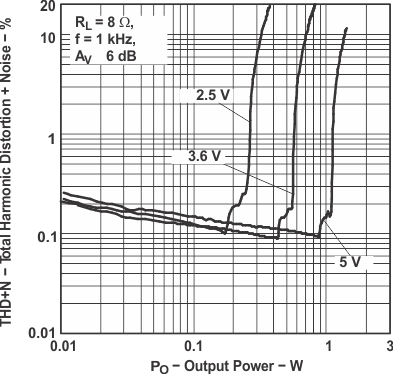 Figure 2. Total Harmonic Distortion
Figure 2. Total Harmonic Distortionvs Output Power
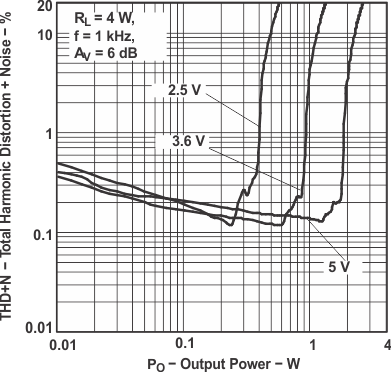 Figure 4. Total Harmonic Distortion
Figure 4. Total Harmonic Distortionvs Output Power
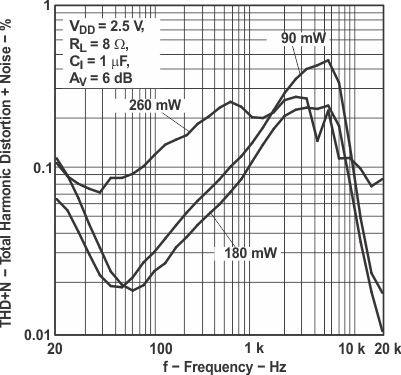 Figure 6. Total Harmonic Distortion vs Frequency
Figure 6. Total Harmonic Distortion vs Frequency
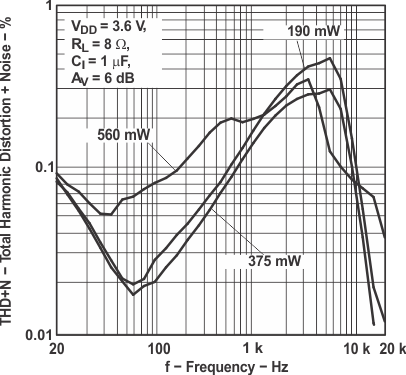 Figure 8. Total Harmonic Distortion vs Frequency
Figure 8. Total Harmonic Distortion vs Frequency
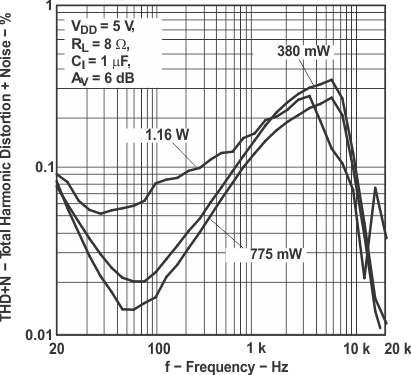 Figure 10. Total Harmonic Distortion vs Frequency
Figure 10. Total Harmonic Distortion vs Frequency
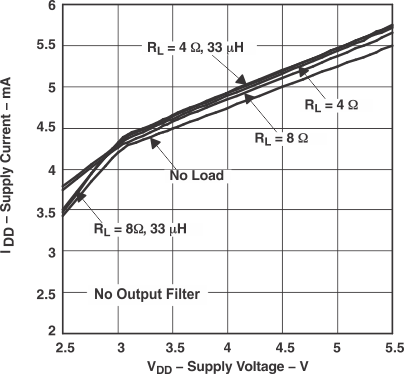 Figure 12. Supply Current vs Supply Voltage
Figure 12. Supply Current vs Supply Voltage
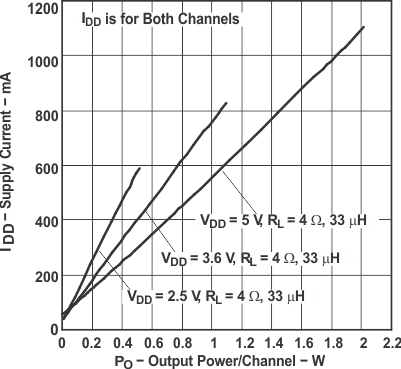 Figure 14. Supply Current vs Output Power
Figure 14. Supply Current vs Output Power
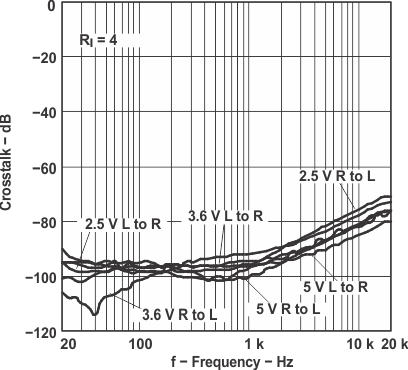 Figure 16. Crosstalk vs Frequency
Figure 16. Crosstalk vs Frequency
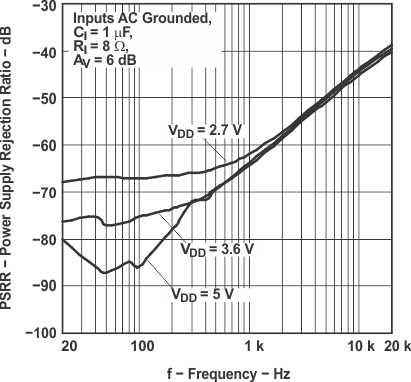 Figure 18. Power Supply Rejection Ratio
Figure 18. Power Supply Rejection Ratiovs Frequency
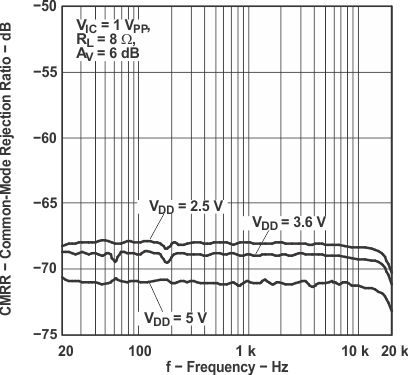 Figure 20. Common-Mode Rejection Ratio
Figure 20. Common-Mode Rejection Ratiovs Frequency
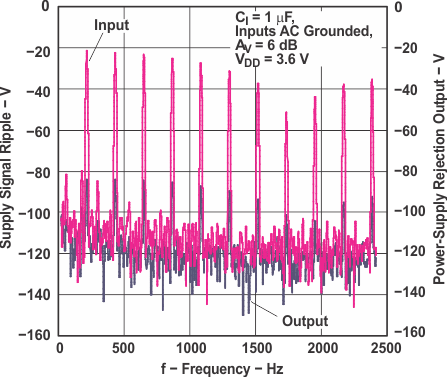 Figure 22. Power Supply Rejection vs Frequency
Figure 22. Power Supply Rejection vs Frequency
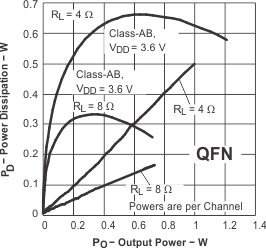 Figure 24. Power Dissipation vs Output Power
Figure 24. Power Dissipation vs Output Power
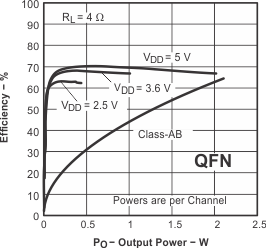 Figure 26. Efficiency vs Output Power
Figure 26. Efficiency vs Output Power
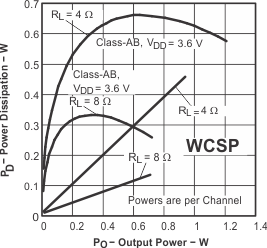 Figure 28. Power Dissipation vs Output Power
Figure 28. Power Dissipation vs Output Power
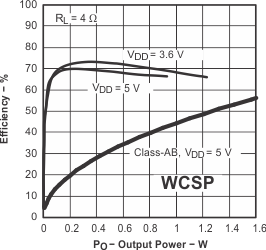 Figure 30. Efficiency vs Output Power
Figure 30. Efficiency vs Output Power
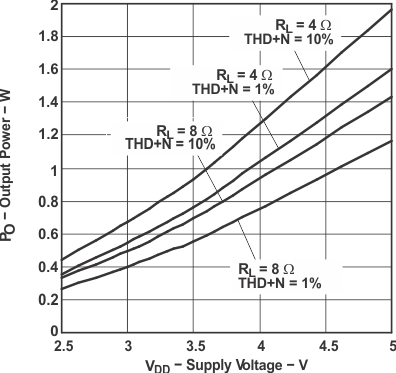 Figure 32. Output Power vs Supply Voltage
Figure 32. Output Power vs Supply Voltage
8 Parameter Measurement Information
All parameters are measured according to the conditions described in the Specifications. Figure 34 shows the setup used for the typical characteristics of the test device.
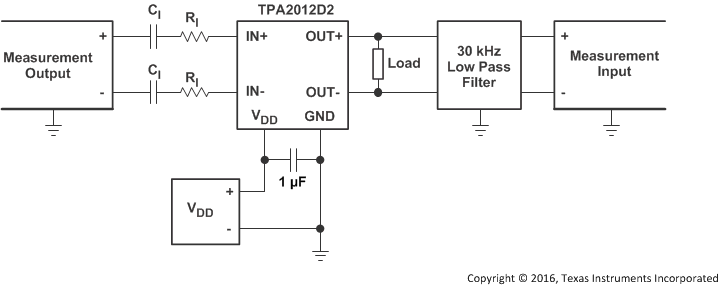
(100 Ω, 47 nF) is used on each output for the data sheet graphs.
9 Detailed Description
9.1 Overview
The TPA2012D2 is capable of driving 1.4 W/Ch at 5-V or 720 mW/Ch at 3.6-V into 8 Ω. The TPA2012D2 is also capable of driving a load of 4 Ω.
The TPA2012D2 feature independent shutdown controls for each channel. High PSRR and differential architecture provide increased immunity to noise and RF rectification. The TPA2012D2 provides thermal and short-circuit protection.
9.2 Functional Block Diagram
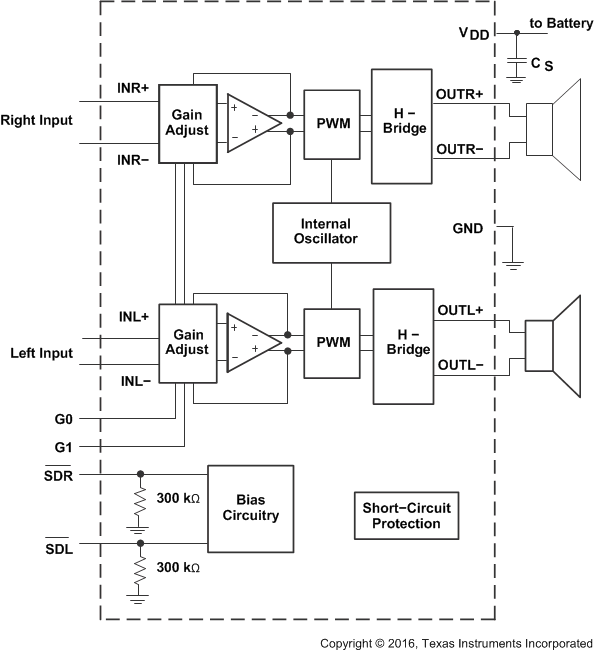
9.3 Feature Description
9.3.1 Fixed Gain Setting
The TPA2012D2 has 4 selectable fixed gains: 6 dB, 12 dB, 18 dB, and 24 dB. Connect the G0 and G1 pins as shown in Table 1.
Table 1. Gain Setting
| G1 | G0 | GAIN (V/V) |
GAIN (dB) |
INPUT IMPEDANCE (RI, kΩ) |
|---|---|---|---|---|
| 0 | 0 | 2 | 6 | 28.1 |
| 0 | 1 | 4 | 12 | 17.3 |
| 1 | 0 | 8 | 18 | 9.8 |
| 1 | 1 | 16 | 24 | 5.2 |
9.3.2 Short-Circuit Protection
TPA2012D2 goes to low duty cycle mode when a short-circuit event happens. To return to normal duty cycle mode, the device must be reset. The shutdown mode can be set through the SDL and SDR pins, or the device can be turned off and turned on to return to normal duty cycle mode. This feature protects the device without affecting long-term reliability.
9.3.3 Operation With DACs and CODECs
In using Class-D amplifiers with CODECs and DACs, sometimes there is an increase in the output noise floor from the audio amplifier. This occurs when mixing of the output frequencies of the CODEC and DAC mix with the switching frequencies of the audio amplifier input stage. The noise increase can be solved by placing a low-pass filter between the CODEC, DAC, and audio amplifier. This filters off the high frequencies that cause the problem and allow proper performance. The recommended resistor value is 100 Ω and the capacitor value of 47 nF. Figure 35 shows the typical input filter.
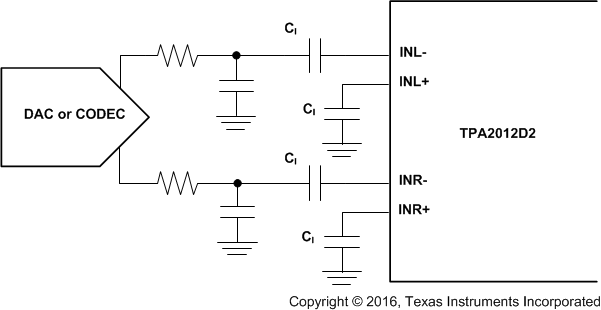 Figure 35. Reducing Out-of-Band DAC Noise With External Input Filter
Figure 35. Reducing Out-of-Band DAC Noise With External Input Filter
9.3.4 Filter-Free Operation and Ferrite Bead Filters
A ferrite bead filter can often be used if the design is failing radiated emissions without an LC filter and the frequency sensitive circuit is greater than 1 MHz. This filter functions well for circuits that just have to pass FCC and CE because FCC and CE only test radiated emissions greater than 30 MHz. When choosing a ferrite bead, choose one with high impedance at high frequencies, and very low impedance at low frequencies. In addition, select a ferrite bead with adequate current rating to prevent distortion of the output signal.
Use an LC output filter if there are low frequency (< 1 MHz) EMI sensitive circuits and/or there are long leads from amplifier to speaker.
Figure 36 shows typical ferrite bead and LC output filters.
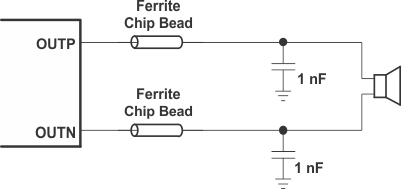 Figure 36. Typical Ferrite Chip Bead Filter (Chip Bead Example: TDK – MPZ1608S221A)
Figure 36. Typical Ferrite Chip Bead Filter (Chip Bead Example: TDK – MPZ1608S221A)
9.4 Device Functional Modes
9.4.1 Shutdown Mode
The TPA2012D2 amplifier can be put in shutdown mode when asserting SDR and SDL pins to a logic LOW. While in shutdown mode, the device output stage is turned off and the current consumption is very low.
10 Application and Implementation
NOTE
Information in the following applications sections is not part of the TI component specification, and TI does not warrant its accuracy or completeness. TI’s customers are responsible for determining suitability of components for their purposes. Customers should validate and test their design implementation to confirm system functionality.
10.1 Application Information
These typical connection diagrams highlight the required external components and system level connections for proper operation of the device. Each of these configurations can be realized using the evaluation modules (EVMs) for the device. These flexible modules allow full evaluation of the device in the most common modes of operation. Any design variation can be supported by TI through schematic and layout reviews. Visit e2e.ti.com for design assistance and join the audio amplifier discussion forum for additional information.
10.2 Typical Applications
10.2.1 TPA2012D2 With Differential Input Signal
10.2.1.1 Design Requirements
For this design example, use the parameters listed in Table 2.
Table 2. Design Parameters
| PARAMETER | VALUE |
|---|---|
| Power supply | 5 V |
| Enable inputs | High > 1.3 V |
| Low < 0.35 V | |
| Speaker | 8 Ω |
10.2.1.2 Detailed Design Procedure
10.2.1.2.1 Surface Mount Capacitors
Temperature and applied DC voltage influence the actual capacitance of high-K materials. Table 3 shows the relationship between the different types of high-K materials and their associated tolerances, temperature coefficients, and temperature ranges. Notice that a capacitor made with X5R material can lose up to 15% of its capacitance within its working temperature range.
In an application, the working capacitance of components made with high-K materials is generally much lower than nominal capacitance. A worst-case result with a typical X5R material might be –10% tolerance, –15% temperature effect, and –45% DC voltage effect at 50% of the rated voltage. This particular case would result in a working capacitance of 42% (0.9 × 0.85 × 0.55) of the nominal value.
Select high-K ceramic capacitors according to the following rules:
- Use capacitors made of materials with temperature coefficients of X5R, X7R, or better.
- Use capacitors with DC voltage ratings of at least twice the application voltage. Use minimum 10-V capacitors for the TPA2012D2.
- Choose a capacitance value at least twice the nominal value calculated for the application. Multiply the nominal value by a factor of 2 for safety. If a 10-µF capacitor is required, use 20 µF.
The preceding rules and recommendations apply to capacitors used in connection with the TPA2012D2. The TPA2012D2 cannot meet its performance specifications if the rules and recommendations are not followed.
Table 3. Typical Tolerance and Temperature Coefficient of Capacitance by Material
| MATERIAL | COG/NPO | X7R | X5R |
|---|---|---|---|
| Typical tolerance | ±5% | ±10% | 80% to –20% |
| Temperature | ±30 ppm | ±15% | 22% to –82% |
| Temperature range (°C) | –55°C to 125°C | –55°C to 125°C | –30°C to 85°C |
10.2.1.2.2 Decoupling Capacitor (CS)
The TPA2012D2 is a high-performance Class-D audio amplifier that requires adequate power supply decoupling to ensure the efficiency is high and total harmonic distortion (THD) is low. For higher frequency transients, spikes, or digital hash on the line a good low equivalent-series-resistance (ESR) ceramic capacitor, typically
1 µF, placed as close as possible to the device PVDD lead works best. Placing this decoupling capacitor close to the TPA2012D2 is important for the efficiency of the Class-D amplifier, because any resistance or inductance in the trace between the device and the capacitor can cause a loss in efficiency. For filtering lower-frequency noise signals, a 4.7 µF or greater capacitor placed near the audio power amplifier would also help, but it is not required in most applications because of the high PSRR of this device.
10.2.1.2.3 Input Capacitors (CI)
The TPA2012D2 does not require input coupling capacitors if the design uses a differential source that is biased from 0.5 V to VDD – 0.8 V. If the input signal is not biased within the recommended common-mode input range, if high-pass filtering is needed (see Figure 37), or if using a single-ended source (see Figure 38), input coupling capacitors are required.
The input capacitors and input resistors form a high-pass filter with the corner frequency, fc, determined in Equation 1.

The value of the input capacitor is important to consider as it directly affects the bass (low frequency) performance of the circuit. Speakers in wireless phones cannot usually respond well to low frequencies, so the corner frequency can be set to block low frequencies in this application. Not using input capacitors can increase output offset.
Equation 2 is used to solve for the input coupling capacitance.

If the corner frequency is within the audio band, the capacitors should have a tolerance of ±10% or better, because any mismatch in capacitance causes an impedance mismatch at the corner frequency and below.
10.2.1.3 Application Curves
For application curves, see the figures listed in Table 4.
10.2.2 TPA2012D2 With Single-Ended Input Signal
 Figure 38. Typical Application Schematic With Single-Ended Input Signal
Figure 38. Typical Application Schematic With Single-Ended Input Signal
10.2.2.1 Design Requirements
For this design example, use the parameters listed in Table 2.
10.2.2.2 Detailed Design Procedure
For the design procedure, see Detailed Design Procedure from the previous example.
10.2.2.3 Application Curves
For application curves, see the figures listed in Table 4.
